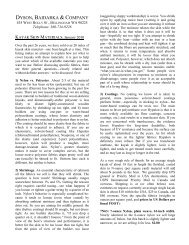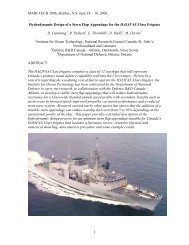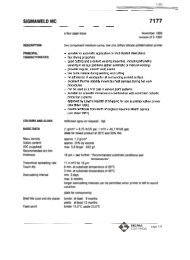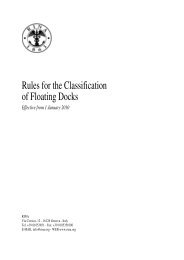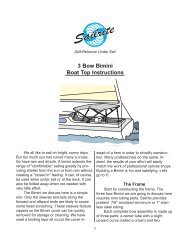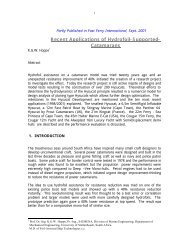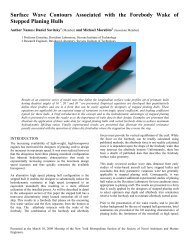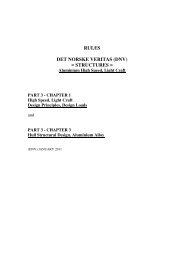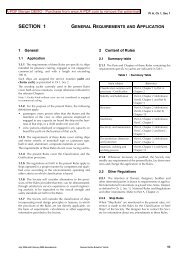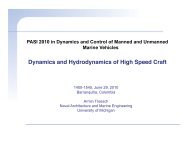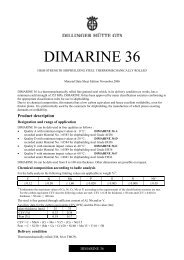Origin and Characteristics of the Spray Patterns TR-2882 3-10 ...
Origin and Characteristics of the Spray Patterns TR-2882 3-10 ...
Origin and Characteristics of the Spray Patterns TR-2882 3-10 ...
Create successful ePaper yourself
Turn your PDF publications into a flip-book with our unique Google optimized e-Paper software.
<strong>TR</strong>-<strong>2882</strong><br />
Where X’ =X/b<br />
Likewise <strong>the</strong> transverse distance, Y, between <strong>the</strong> point <strong>of</strong> maximum spray height <strong>and</strong> <strong>the</strong> side <strong>of</strong> <strong>the</strong> hull is:<br />
So that;<br />
Y = Ltr sinα<br />
Eq. 23<br />
Y '<br />
= sinγ<br />
cosγ<br />
sinα<br />
2<br />
Cv<br />
Eq. 24<br />
Where Y’ = Y/b<br />
The quantities X’/ Cv 2 <strong>and</strong> Y’/ Cv 2 are plotted on Fig 15B as a function <strong>of</strong> deadrise angle with trim angle as a<br />
parameter.<br />
It is important to remember that X’, <strong>and</strong> Y’ are dimensions relative to <strong>the</strong> location <strong>of</strong> <strong>the</strong> maximum height, Zmax, that<br />
is located on <strong>the</strong> centerline <strong>of</strong> <strong>the</strong> main spray geometry. Since this analysis is based upon <strong>the</strong> application <strong>of</strong> kinematic<br />
considerations, <strong>the</strong> actual pr<strong>of</strong>ile <strong>of</strong> <strong>the</strong> spray height along <strong>the</strong> centerline <strong>of</strong> <strong>the</strong> main spray can be calculated using<br />
st<strong>and</strong>ard trajectory equations<br />
EXPERIMENTAL STUDIES<br />
The experimental investigations performed in this study <strong>of</strong> <strong>the</strong> spray patterns associated with planing surfaces included<br />
basic explorations to identify <strong>the</strong> origin <strong>of</strong> <strong>the</strong> spray patterns <strong>and</strong> also detailed measurements to relate <strong>the</strong> main spray<br />
geometry with hull deadrise, running trim angle <strong>and</strong> speed.<br />
Exploratory Tests<br />
Dye Injection Tests. To define <strong>the</strong> division <strong>of</strong> <strong>the</strong> undisturbed water surface into <strong>the</strong> whisker <strong>and</strong> main sprays, a<br />
series <strong>of</strong> observations were made <strong>of</strong> <strong>the</strong>ir steady state patterns when a blue dye stream was deposited on <strong>the</strong> water<br />
surface at various locations forward <strong>of</strong> <strong>and</strong> alongside <strong>the</strong> towed model. The dye was carried in a hopper attached to <strong>the</strong><br />
towing carriage <strong>and</strong> was released as a continuous, thin, liquid stream. The locations at which <strong>the</strong> dye was released onto<br />
<strong>the</strong> free water surface are shown on Fig. 16. The test model was a 5 inch beam, 20 deg deadrise hull that was towed at a<br />
fixed trim angle <strong>of</strong> 8 deg, a Cv <strong>of</strong> 3.00 <strong>and</strong> a mean wetted length beam ratio <strong>of</strong> 2.51. An analysis <strong>of</strong> <strong>the</strong> resultant<br />
trajectories <strong>of</strong> each <strong>of</strong> <strong>the</strong>se dye streams provided <strong>the</strong> following observations relative to <strong>the</strong> origin <strong>of</strong> <strong>the</strong> spray patterns.<br />
The dye was first introduced at position #1 (intersection <strong>of</strong> <strong>the</strong> stagnation line with <strong>the</strong> chine) to review <strong>the</strong> assumption<br />
that <strong>the</strong> main spray issues from a single small region on <strong>the</strong> chine. As had been expected, <strong>the</strong> entire main spray blister<br />
became colored blue. When <strong>the</strong> dye injection point was moved slightly forward to position #2 (in <strong>the</strong> area <strong>of</strong> <strong>the</strong><br />
whisker spray) <strong>the</strong> main spray was uncolored <strong>and</strong> streaks <strong>of</strong> blue appeared in <strong>the</strong> area <strong>of</strong> <strong>the</strong> whisker spray surrounding<br />
<strong>the</strong> point <strong>of</strong> dye injection. The blue dye stream was <strong>the</strong>n injected at positions aft <strong>of</strong> <strong>the</strong> stagnation line intersection with<br />
<strong>the</strong> chine <strong>and</strong> alongside <strong>the</strong> chine (positions #3 <strong>and</strong> #4). In <strong>the</strong>se positions, <strong>the</strong> main spray remained uncolored <strong>and</strong> <strong>the</strong><br />
blue dye appeared as a thin stream in <strong>the</strong> wake aft <strong>of</strong> <strong>the</strong> test model.<br />
The hopper was <strong>the</strong>n moved to a position 2 beams ahead <strong>of</strong> <strong>the</strong> wetted keel length <strong>and</strong> dye streams were introduced<br />
onto <strong>the</strong> water surface at positions #5, #6, #7, #8, #9, <strong>and</strong> #<strong>10</strong>. In position #5, (at <strong>the</strong> extension <strong>of</strong> <strong>the</strong> keel line),<br />
occasional streaks <strong>of</strong> blue appeared in <strong>the</strong> whisker spray but <strong>the</strong> main spray was uncolored. A major portion <strong>of</strong> this dye<br />
appeared as a blue streak starting at <strong>the</strong> transom <strong>and</strong> running aft along <strong>the</strong> longitudinal extension <strong>of</strong> <strong>the</strong> hull centerline.<br />
At position #6 substantial areas <strong>of</strong> <strong>the</strong> whisker spray were colored but <strong>the</strong> main spray <strong>and</strong> wake remained uncolored.<br />
When <strong>the</strong> dye was released at positions #7, #8, <strong>and</strong> #9 <strong>the</strong> main spray was colored but <strong>the</strong> whisker spray <strong>and</strong> trailing<br />
wake remained uncolored. .For position #<strong>10</strong> both <strong>the</strong> whisker <strong>and</strong> main spray were uncolored A thin blue streak line<br />
parallel to <strong>the</strong> chine appeared on <strong>the</strong> water surface <strong>and</strong> extended from <strong>the</strong> point <strong>of</strong> release <strong>of</strong> <strong>the</strong> dye to well aft <strong>of</strong> <strong>the</strong><br />
model transom.<br />
The conclusions from this exploratory dye study reaffirmed <strong>the</strong> conviction that <strong>the</strong> main spray blister originates at a<br />
small region at <strong>the</strong> intersection <strong>of</strong> <strong>the</strong> stagnation line with <strong>the</strong> chine. It also showed that:<br />
8



